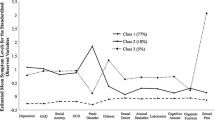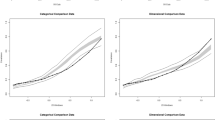Abstract
There are at least three approaches by which psychopathology can be described in terms of dimensions. Each approach involves counting the number and severity of symptoms, but these scores have distinct meanings based on whether the latent construct is considered to be categorical or dimensional. Given a categorical construct, dimensions can index either diagnostic certainty or symptom severity. For inherently dimensional constructs, the severity of the symptoms is essentially isomorphic with the underlying latent dimension. The optimal number of dimensions for describing paraphilias is not known, but would likely include features related to problems in sexual self-regulation, the diversity of paraphilic interests, and the overall intensity of sexual drive and expression. Complex measures of these (and related) dimensions currently exist, but simplified criteria are needed for routine communication among diverse mental health professionals. Establishing these criteria would requires professional consensus on the nature of the latent dimensions, as well as reliable assessment of the core constructs using non-arbitrary scales of measurement.
Similar content being viewed by others
References
Abel, G. G., Becker, J. V., Cunningham-Rathner, J., Mittelman, M., & Rouleau, J. (1988). Multiple paraphilic diagnoses among sex offenders. Bulletin of the American Academy of Psychiatry and the Law, 16, 153–168.
Akobeng, A. K. (2006). Understanding diagnostic tests 2: Likelihood ratios, pre- and post-test probabilities and their use in clinical practice. Acta Paediatrica, 96, 487–491.
Blanton, H., & Jaccard, J. (2006). Arbitrary metrics in psychology. American Psychologist, 61, 27–41.
Brown, T. A., & Barlow, D. H. (2009). A proposal for a dimensional classification system based on the shared features of the DSM-IV anxiety and mood disorders: Implications for assessment and treatment. Psychological Assessment, 21, 256–271.
Carnes, P. (1989). Contrary to love: Helping the sexual addict. Minneapolis, MN: CompCare Publishers.
Coleman, E., Miner, M., Ohlerking, F., & Raymond, N. (2001). Compulsive Sexual Behavior Inventory: A preliminary study of reliability and validity. Journal of Sex and Marital Therapy, 27, 325–332.
Guay, J. P., Ruscio, J., Knight, R. A., & Hare, R. D. (2007). A taxometric analysis of the latent structure of psychopathy: Evidence for dimensionality. Journal of Abnormal Psychology, 116, 701–716.
Heil, P., & English, K. (2009). Sex offender polygraph testing in the United States: Trends and controversies. In D. T. Wilcox (Ed.), The use of the polygraph in assessing, treating and supervising sex offenders: A practitioner’s guide (pp. 181–216). Chichester, England: Wiley.
Helzer, J. E., Kraemer, H. C., Krueger, R. F., Wittchen, H.-U., Sirovatka, P. J., & Regier, D. A. (Eds.). (2008). Dimensional approaches in diagnostic classification: Refining the research agenda for DSM-V. Arlington, VA: American Psychiatric Association.
Kalichman, S. C., & Rompa, D. (1995). Sexual sensation seeking and sexual compulsivity scales: Reliability, validity, and predicting HIV risk behaviors. Journal of Personality Assessment, 65, 586–602.
Lalumière, M. L., & Harris, G. T. (2008, October). What accounts for ‘penile indifference’ among sex offenders? Paper presented at the meeting of the Research and Treatment Conference of the Association for the Treatment of Sexual Abusers, Atlanta, GA.
Langevin, R., & Paitich, D. (2002). The Clarke Sex History Questionnaire for Males-Revised (SHQ-R) technical manual. Toronto: Multi-Health Systems.
Långström, N., & Hanson, R. K. (2006). High rates of sexual behavior in the general population: Correlates and predictors. Archives of Sexual Behavior, 35, 37–52.
Maser, J. D., Norman, S. B., Zisook, S., Everall, I. P., Stein, M. B., Schettler, P. J., et al. (2009). Psychiatric nosology is ready for a paradigm shift in DSM-V. Clinical Psychology: Science and Practice, 16, 24–40.
Michell, J. (1990). An introduction to the logic of psychological measurement. Hillsdale, NJ: Lawrence Erlbaum Associates.
Raymond, N. C., Coleman, E., Ohlerking, F., Christenson, G. A., & Miner, M. (1999). Psychiatric comorbidity in pedophilic sex offenders. American Journal of Psychiatry, 156, 786–788.
Seto, M. C. (2008). Pedophilia and sexual offending against children: Theory, assessment, and intervention. Washington, DC: American Psychological Association.
Seto, M. C., & Lalumière, M. L. (2001). A brief screening scale to identify pedophilic interests among child molesters. Sexual Abuse: A Journal of Research and Treatment, 13, 15–25.
Slade, T., Grove, R., & Teesson, M. (2009). A taxometric study of alcohol abuse and dependence in a general population sample: Evidence of dimensional latent structure and implications for DSM-V. Addiction, 104, 742–751.
Suschinsky, K. D., Lalumière, M. L., & Chivers, M. L. (2009). Sex differences in patterns of genital sexual arousal: Measurement artifacts or true phenomena? Archives of Sexual Behavior, 38, 559–573.
Wilson, G. (1978). The secrets of sexual fantasy. London: J. M. Dent & Sons.
Acknowledgments
The author is an advisor to the Paraphilias subworkgroup of the DSM-V Sexual and Gender Identity Disorders Workgroup (Chair, Kenneth J. Zucker, Ph.D.). This article is a revised version of a commentary submitted on July 17, 2009 to the Workgroup. I would like to thank Jobina Li for help with the references. The views expressed are those of the author and not necessarily those of Public Safety Canada. Reprinted with permission from the Diagnostic and Statistical Manual of Mental Disorders V Workgroup Reports (Copyright 2009), American Psychiatric Association.
Author information
Authors and Affiliations
Corresponding author
Rights and permissions
About this article
Cite this article
Hanson, R.K. Dimensional Measurement of Sexual Deviance. Arch Sex Behav 39, 401–404 (2010). https://doi.org/10.1007/s10508-009-9575-6
Published:
Issue Date:
DOI: https://doi.org/10.1007/s10508-009-9575-6




